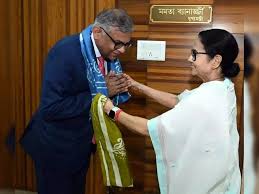Okay, Tata: How Mamata govt is trying to put Nano in the rearview mirror

Over 15 years after Tata Motors exited Singur, West Bengal is still managing the political and industrial fallout. The Nano, once hailed as India’s “people’s car,” has become a symbol of missed opportunities and deep political divides. Today, the Mamata Banerjee-led government seems determined to bury that chapter and move forward.
From policy reversals to public posturing, the Trinamool Congress (TMC) is reshaping Bengal’s industrial story. The Nano project no longer fits that narrative.
The Singur Flashpoint
In 2008, Tata Motors walked away from its nearly complete plant in Singur. Protests over land acquisition, led by Mamata Banerjee, had made the project untenable. That movement catapulted her into power in 2011, ending the Left Front’s 34-year rule.
The cost of that political victory was high. Bengal lost a flagship industrial project. The plant was dismantled. Farmers reclaimed their land. But investors began viewing the state with caution.
The Supreme Court later ruled the land acquisition illegal. The judgment returned land to its original owners. Yet, the larger damage—to Bengal’s image as an investment-friendly state—was already done.
Revoking the Past
In March 2025, the West Bengal Assembly passed a law to cancel all industrial incentives offered since 1993. This included benefits once extended to Tata Motors.
The government said it needed the funds for public welfare. It also promised a new industrial policy. Officials described the move as a clean break from the past. They argued that it would create a transparent and fair investment environment.
Critics disagreed. They warned that such retroactive steps could erode investor confidence. Businesses, they argued, need consistency more than anything else. Despite the pushback, the state didn’t back down.
The Compensation Dispute
Tata Motors had filed for compensation after its exit from Singur. In 2023, an arbitration panel awarded the company ₹766 crore. The ruling added financial strain to Bengal’s already tight budget.
The state offered land instead of cash. Tata refused. It asked for a refund of ₹154 crore spent during the project.
This standoff reflects more than just financial tension. Tata wants accountability. The government, on the other hand, doesn’t want to appear responsible for the failure.
Mamata Banerjee’s administration continues to frame the conflict as one rooted in justice for farmers. That position remains popular among her voter base.
A Political Symbol
Mamata Banerjee has never softened her stance on the Nano project. She once declared she would never ride in a Nano. In another instance, she called it a car “built with the blood of farmers.”
These statements turned the Nano into a political icon. In Bengal, the car became a symbol of resistance rather than progress. The government’s continued rejection of Tata’s claims reinforces this narrative.
For Banerjee, the Nano is a reminder of a fight she won. But it’s also something she wants voters to see as a past mistake—not the future of Bengal.
Signs of a Thaw
Despite the lingering tensions, things may be shifting. In July 2025, Tata Group chairman Natarajan Chandrasekaran met Mamata Banerjee at Nabanna. It was their first formal meeting in 14 years.
No deals were signed. But the meeting signaled a willingness to start fresh. For Tata, Bengal still offers untapped potential. For the state, the group remains a trusted name in Indian industry.
The interaction suggests that both sides are open to dialogue. Banerjee may be looking to reposition Bengal as a viable investment destination without compromising her political legacy.
Looking Ahead
The Nano project is history. But the battle over its legacy continues. The upcoming industrial policy will reveal whether West Bengal is serious about shedding its anti-industry image.
The government says the new policy will balance fairness, sustainability, and growth. It remains to be seen how that vision plays out. Businesses want more than promises—they want proof.
For Bengal, the challenge lies in proving that it has learned from the Singur episode. That means offering clear, consistent rules and a stable policy environment.
Conclusion
Mamata Banerjee built her political career on the back of the Singur protests. The Tata Nano exit helped define her rise. But times have changed. The same story that once brought her to power may now hold Bengal back.
The TMC government appears ready to move on. By rewriting policies, confronting old contracts, and signaling openness to new talks, it hopes to steer the state in a new direction.
For Bengal to attract the industries it needs, it must first show that the past is behind it. The Nano remains in the mirror—but the road ahead must look different.






